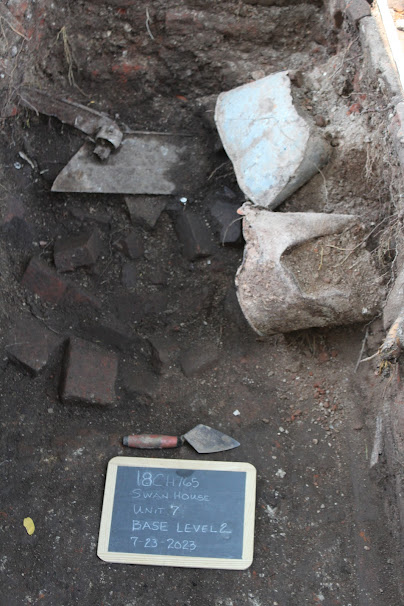Now that the dog days of August are over we are back out in the field - weather permitting. Over the next few weeks we’ll be working on closing up the units we opened this summer at the Swann House Site and then moving out to Maxwell Hall State Park, where we have a grant from the Southern Maryland National Heritage Area to do survey work. We’ll be back at Swann House in the Spring. While we’re finishing up our units at the Swann House, I thought I’d share some photographs of the work we’ve done over the spring and summer.
 |
Clearing the area over the foundation Left to Right, Mimi, Carol, Denise, Elsie, Ned, and Mary 3 April 2023 |
 |
Ned cutting tree limbs, the Swann House foundation is on the left side of the photo 3 April 2023 |
 |
Break Time! Left to Right Doug, Ned, Linda, and Elsie 12 April 2023 |
Once the brush was cleared we began the excavation units.
 |
The photo was taken the last day of clearing and was the day we found the snake. Left to right: Elsie, Denise, Carol, Pat, Doug and exiting on the right (or stage left) - Ned 12 April 2023 |
 |
With help from the students, members of CCASM and the volunteer crew, Steve reached the brick floor of the hearth in the kitchen under all the chimney fall 6 May 2023 |
 |
We also opened up two units out in the field on the south side of the house. At least we didn't have to clear brush here. Elsie and Ned, hard at work troweling. 19 June 2023 |
 |
Our second public archaeology week was June 24th and 25th. We continued to work in the house and field units. Left to right: Elsie, Tamara, and Carol screening soil in order to look for artifacts. |
 |
It can be hard work, but we had fun! Linda and Denise in one of the field units. 24 June 2023 |
 |
Clean-up time at the end of the day. Carol and Linda covering over the units next to the foundation Elsie, Tamara, and Kim finishing up the screening. 24 June 2023. |
And then there were the summer storms...
 |
It seems that every Monday from the beginning of July through September began the same way, a unit filled with water and... |
 |
Me in my Wellies filling buckets of water while the crew hauled them out in the field and dumped them. 9/11/2023 |
In addition to the field work, we also had some young visitors who learned about artifacts and reconstructing vessels. We look forward to hosting more students this fall.
 |
Ned and Kathy work with students on a vessel reconstruction excercise |
Recovering artifacts during the excavation led to lots of lab work in July and August. While some of us were out in the field, another group was in the lab trying to keep up with the washing.
 |
Ceramics in one of the drying trays. 11 September 2023 |
Once we’ve cleaned all the artifacts we’ll start with the formal cataloging and analysis, something that will keep us busy all winter. Below are examples of some of things we’ve found. I’ve also discussed some of the artifacts in other blogs about Swann House over the summer.
 |
Fragments of tin-glazed earthenware associated with 18th-century occupants of the site. Recovered in the field units. |
 |
2nd to 3rd quarter 19th-century ceramics associated with the Swann Family's occupation of the site Recovered in the field units. |
 |
Late 19th-century bottle lip and neck Swann Family occupation Recovered in the field units. |
 |
Chipping debris from stone tool production Long before the village of Port Tobacco existed the Potapoco Indians lived there. Recovered in the field units. |
 |
20th-century Zinc Canning Jar Lid with Milk Glass insert House Foundation Units Sallie Swann or Bush family occupation |
 |
Pre-Prohibition Pabst Blue Ribbon Beer Bottle Fragments House Foundation Units. Sallie Swann or Bush Family occupation |
 |
Mid-19th century tobacco pipe stem The pipe stem is embossed with part of the word: "Glasgow" Swann Family Occupation |
None of this was possible without the dedicated volunteer archaeology crew: From CCASM - Carol, Claudia, Denise, Doug, Elsie, Kathy, Linda, Mary, Mimi, Ned, Pat, Peggy, and Steve. And also Doria and the Citizens Academy volunteers Kim and Tamara, Charlie of Charles County Recreation, Parks, and Tourism, Charles County Residents Evie, James, and Tiara,UMBC students Alana and Meghan, the volunteers who joined us during our public weekends, and finally my husband Tim.
If you are interested in volunteering, contact me using the email form on the home page.









Comments
Post a Comment